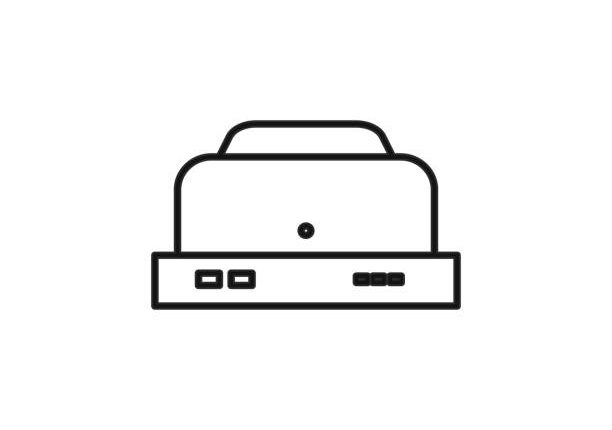Electrophoresis is the most frequently applied separation technique for the analysis of protein, glycan, and nucleic acid mixtures. With electrophoresis high separation efficiency can be achieved using a relatively simple set of equipment. It is mainly applied for analytical rather than for preparative purpose.
Principle:
Electrophoresis is derived from two greek word namely, “Electro” (means electricity) and “Phoresis” (means separation ), thus electrophoresis means separation with the help of electricity.
Under the impact of an electrical field charged molecules or particles migrate into the direction of the electrode bearing the other charge. During this process, the substances are in solution. Because of their varying charge and masses, different molecules and particles of a mixture will migrate at different velocities and will thus be separated into single fraction.
The rate of migration of charged particles depends upon the following factors:
- The strength of electrical field, shape and size
- Relative hydrophobicity of the sample
- Temperature and also the ionic strength of the buffer
- Molecular mass of the taken biomolecule
- Net charge density of the biomolecule is used
- Shape of the taken bio molecule.
BUFFER: the buffer in electrophoresis has two fold purposes:
- Carry applied electric current
- They adjust the pH at which electrophoresis is carried out.
Thus they determine:
- Type of charge on solute. Extent of ionization of solute
- Electrode towards which the solute migrate.
- The ionic strength of buffer will determine the thickness of the ionic cloud.
SUPPORTING MEDIUM
Supporting medium may be a matrix during which the protein separation takes place. Various types has been used for the separation either on slab or capillary type. Separation is based on to the charge to mass ratio of the protein depending on the pre size of the medium, probably the molecular size.
WORKING OF ELECTROPHORESIS
The basic working principle of the electrophoresis is that it create the separation of the molecules, ions or colloidal particles that suspends within the matrix under the force of an electrical field. The electric field allows the migration of charged molecule towards the anode and therefore the migration of charged molecule towards the cathode. Therefore, electrophoresis is the electro kinetic phenomenon where the motion of the molecules occurs under the electric field.
TYPES OF ELECTROPHORESIS
- Electrophoresis is basically of two types:
- Free boundary or moving boundary electrophoresis
- Zone electrophoresis
- MOVING BOUND ELECTROPHORESIS
- It is a type of electrophoresis having no supporting media, in a free solution.
- Tiselius developed this type of electrophoresis in 1937, for which he is referred as FATHER OF ELECTROPHORESIS.
- For the separation of different charged molecules in a mixture, sample is placed in glass, electrodes through it . On applying potential across the tube, charged molecule migrates towards one or another electrode.
- Moving boundary electrophoresis is performed out in a U tube having platinum electrodes attached to the end of both ends. At the respective ends, tube has refractometer to live the change in index of refraction the buffer during electrophoresis thanks to presence of molecule.
- Sample is placed in the middle of the U shape tube and then the apparatus is connected to the external power supply.
- Charged molecule moves to the opposite electrode as they pass across the refractometer, a change can be noticed.
- As the desirable molecule passes, sample can be removed from the apparatus along with the buffer.
- Following are the sub-types of zone electrophoresis:
- Capillary electrophoresis
- Isotachophoresis
- Isolectric focusing
- Immuno electrophoresis
- Capillary electrophoresis
- ZONE ELECTROPHORESIS
- It involves the separation of oppositively charged particles on inert matrix, or supporting or stabilizing medium.
- The zone electrophoresis method involves an inert polymeric supporting medium which is placed in between the electrodes to separate and analyze the sample. The stabilizing media is employed in zone electrophoresis are adsorbent paper, gel of starch, and polyacrylamide.
- The main use of supporting media is that the it reduces mixing of the sample and immobilization of the molecule after electrophoresis.
- The gel electrophoresis is that the top example of zone electrophoresis.
- Following are the sub – types of zone electrophoresis.
- Paper electrophoresis
- Gel electrophoresis
- Thin layer electrophoresis
- Cellulose acetate electrophoresis
- ON THE BASIS OF SUPPORTINNG MEDIA, IT IS OF FOLLOWING TYPES:
- Paper electrophoresis
- Cellulose acetate electrophoresis
- Capillary electrophoresis
- Gel electrophoresis
ELECTROPHOREETIC UNIT IS OF TWO TYPES:
- Vertical electrophoretic unit
- Horizontal electrophoretic unit
VERTICAL ELECTROPHORETIC UNIT
- It is well known as vertical slab gel units
- It is available commercially and commonly used to separate proteins in acrylamide gels.
- In this, gel is formed between the two glass plates that are fastened together but uses plastic spacers to hold them apart.
- Dimensions of gel are normally: 8.5cm wide X 5 cm high, thickness = 0.51mm.
HORIZONTAL ELECTROPHORETIC UNIT
- In this, a gel is diffuse on a plate, horizontally and submerged in a buffer.
- This apparatus in mostly used to separate nucleic acid or proteins in agarose gel.
PAPER ELECTROPHORESIS
In this kind of electrophoresis a paper have slight adsorption capacity and uniform pore size is employed because the supporting medium for separation of samples under the influence of an applied electrical field.

PRINCIPLE OF PAPER ELECTROPHORESIS
This type of electrophoresis is beneficial for the separation of small- charged molecules, like amino acids and little proteins using strip of paper ( chromatography paper).
When charged molecules are migrate toward either the positive or negative pole when placed under the electrical field consistent with their charge. On the contrary to the proteins, which may have either a net positive or net charge, nucleic acids have a consistent charge imparted by their phosphate backbone, and migrate towards the anode.
Relative mobilities are defined with reference to a standard material, which may the solvent front nin chromatography (Rf), as:
Rf= (distance from origin of unknown )/ ( distance from origin of standard )
WORKING OF PAPER ELECTROPHORESIS
In carrier electrophoresis, a paper strip is moistened with buffer and ends of the strip are immersed into buffer reservoirs containing the electrodes. The samples are spotted within the centre of the paper, high voltage is applied, and thus the spots migrate consistent with their charges. After electrophoresis, the separated components are often be detected by a spread of staining techniques, depending upon their chemical identity. Paper electrophoresis can be performed in both horizontal and vertical electrophoretic unit depending upon the type of samples and the method of separation needed.
DETCTION AND QUANTITATIVE ASSAY
For recognition of the unknown electropherogram, compare the unknown electrogram with standard electrogram under standard conditions. Individual components are usually identified by physical properties by the subsequent methods:
Fluorescence
- Staining with Et Bromide solution” and subsequent visualization of the electrophoretogram under UV light makes DNA & RNA fluoresce and thus facilitate their detection.
- Fluorescamine staining is utilized for detecting amino acids, amino acid derivatives, peptides & proteins.
- DANSYI chloride could also be utilized in place of Fluorescamine.
UV Absorption
- Proteins, Peptides & nucleic acids absorb in the range of 260 to 280mm, this property these can be detect.
Staining

Applications
- Serum analysis for diagnosis purpose is carried out by paper electrophoresis.
- Muscle protein (Myosin), egg protein (albumin), milk protein (casein), snake and bug venoms are satisfactorily analysed using carrier electrophoresis
- It is used in separation and identification of alkaloids.
- It is used for testing suitability of municipal water supplies, toxicity of water, and other environmental components.
- Drug-testing industry uses this type of electrophoresis to determine presence of illegal or recreational drugs in job applicants and crime suspects.
Advantages
• It’s Cheaper and quite simpler than other techniques.
• Requires a really less amount of sample for testing.
- It is quite easy to set up and handle the device
• Organic as well as Inorganic substances can be separated using Paper Chromatography.
• High-Sensitivity.
Disadvantage
- It is very old and primitive method whereas many advanced methods are available now.
- It cannot be used to perform a wide array analysis, i.e. Not each and every form of electrophoretic analysis can be performed on this.
- It does not performs quantitative analysis
- Lack of Sensitivity.
- Lack of Reproducibility.
For more updates, subscribe to our blog.









